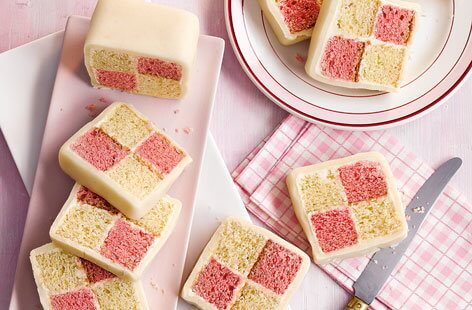
Here’s a most patriotic British sponge cake just as legendary as bread and butter pudding or spotted dick. Let’s do this!
What is Battenberg Cake?
It’s a light sponge cake featuring a lot of jam and marzipan. When you cut the cake, it features a rather pretty and unique check pattern.
Yes, it’s a very fetching looking cake. A rather artistic delight! It’s particularly on our conscience, too, as it became a huge talking point on the Church of Wittertainment.
Dr. Mark Kermode and Simon Mayo turned the cake into another of the show’s in-jokes.
And many fans of the film review show on the BBC now identify to each other with Battenberg cake.
How to Make Battenberg Cake
The most excellent Cupcake Jemma is here to talk you through the finer details. Again, we’re not chefs, dammit. What do we know?
But we’ll let you know the ingredients. Because we’re nice like that. Here they are:
200 grams of unsalted butter, softened, with some for greasing
200 grams caster sugar
1 tablespoon of vanilla extract
3 large eggs
200 grams of self-raising flour, sifted
1 level tablespoon baking powder
¾ x 10g tube pink food colour gel
115 grams of apricot jam
Icing sugar, for dusting
1 x 500 grams of pack natural marzipan
Get all that lot cobbled together and you have that pretty in pink type cake thing. It really is rather marvellous to loot at, no?
The History of Battenberg Cake
This one is as British as they come! The very first Battenberg cake came about in 1884 to celebrate Prince Louis of Battenberg marrying Princess Victoria.
So, yeah, the cake is named after Battenberg of Hesse. But it’s very English, we assure you.
However, some folks do dispute this and suggest the cake was already in existence before then.
Food historian Ivan Day says British bakers simplified the cake to make it easier to create on a production line. So, the monarchy stuff is possibly just patriotic guff.
Whatever’s going on with its origins, we have to say this is a sweet and tasty little cake. Light sponge, nice colours etc. We prefer to stare at it than eat it. Bon!

These cakes seem to show up in a lot of Japanese media, I’ve noticed. I think they show up in Yoshi’s Cookie, though I remember them appearing in the modern version of the Game & Watch game Egg.
LikeLiked by 2 people
The British invasion continues! I did a Google and you’re right, there’s a picture of a Battenberg cake in Yoshi’s Cookie. Huzzah!
LikeLiked by 2 people
The Frenchie will not comment …. Yoshi is a ? a what ? 😀 sorry !
LikeLiked by 1 person
Yoshi is a… dinosaur? Probably. ROAR!
LikeLiked by 1 person
😀
LikeLiked by 1 person
Nothing un-English about Battenberg Cake! Why, it’s as English as Queen Victoria – you know, she was half German, she married a German, and her daughter became Queen of Germany (OK, that joke isn’t original to me…). The Battenbergs themselves were, of course, entirely English, and Prince Louis of Battenberg was the First Sea Lord when the First World War broke out. How English is that? When he was criticised for being a German he insisted he was actually English (but felt he had to resign anyway). His son, Prince George of Battenberg, served aboard HMS New Zealand during the First World War, where he was not even a little bit German despite the rest of the family back in the Grand Duchy of Hesse. I suppose the surname was a tiny bit of a give-away, but that was nothing compared to George Frederick Ernest Albert Saxe-Coburg-Gotha, who happened to be King. I wonder if he ate Battenberg Cake?
LikeLiked by 1 person
That’s blasphemy on this fair island, sir! If you dared mutter those words here the tabloids would identify you as an enemy of the state!!
Excellent historical insights all the same! The House of Saxe-Coburg and Gotha was drenched in Battenberg cake, I’m sure. That an caviar. And scones. Proper British, you know?
LikeLike
Looks great, wanna try some day. I probably saw the Battenberg cake while I was in Tokyo, wish I could find this cake in Taiwan.
LikeLiked by 1 person
You could get adventurous and bake some! Or just order from online. Long haul delivery from Blighty.
LikeLiked by 1 person
Maybe I can try to make one, the supermarket here sells butter and sugar. Just the flour maybe a little bit different. 🙂
LikeLiked by 1 person
Hmmmm. Maybe get an emergency Battenberg cake stash flown in by helicopter. Just remind the cake shop it’s an emergency. 🚁
LikeLiked by 1 person
Hahah😂 Let me try. 🌍
LikeLiked by 1 person